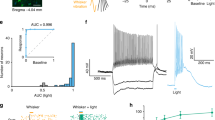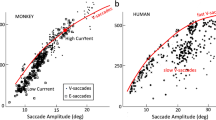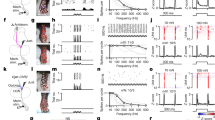Abstract
NEARLY all neurones in the dorsal column nuclei of the cat are either excited or inhibited by stimulation of the pericruciate cortex1–3, the excitation being carried entirely by the pyramidal tract, while inhibition involves an additional route2,3. The cortically excited neurones occupy deep and rostral sites in the dorsal column nuclei, near the pyramidal terminations4,5, while the cortically inhibited neurones are found more superficially. The latter, usually hair-sensitive neurones, possess peripheral inhibitory surrounds6; they may be identified with the cluster neurones, receiving large synaptic terminals7. The former are more often touch-sensitive or pressure-sensitive neurones possessing peripheral facilitatory surrounds6. Thus, neurones excited from one region of cortex are similarly excited from other cortical regions, ipsilateral and contralateral; the same rule holds for inhibition1,2. Few neurones have been observed with both types of cortical influence or with no cortical influence whatever.
This is a preview of subscription content, access via your institution
Access options
Subscribe to this journal
Receive 51 print issues and online access
$199.00 per year
only $3.90 per issue
Buy this article
- Purchase on Springer Link
- Instant access to full article PDF
Prices may be subject to local taxes which are calculated during checkout
Similar content being viewed by others
References
Towe, A. L., and Jabbur, S. J., J. Neurophysiol., 24, 488 (1961).
Jabbur, S. J., and Towe, A. L., J. Neurophysiol., 24, 499 (1961).
Levitt, M., Carreras, M., Liu, C. N., and Chambers, W. W., Arch. Ital. Biol., 102, 197 (1964).
Walberg, F., Brain, 80, 273 (1957).
Kuypers, H. G. J. M., J. Anat., 92, 198 (1958).
Gordon, G., and Jukes, M. G. M., J. Physiol., 173, 263 (1964).
Rozsos, I., Acta Morph. Acad. Sci. Hung., 8, 105 (1958).
Kuypers, H. G. J. M., Brain, 83, 161 (1960).
Andersen, P., Eccles, J. C., Schmidt, R. F., and Yokota, T., J. Neurophysiol., 27, 1080 (1964).
Author information
Authors and Affiliations
Rights and permissions
About this article
Cite this article
HARRIS, F., JABBUR, S., MORSE, R. et al. Influence of the Cerebral Cortex on the Cuneate Nucleus of the Monkey. Nature 208, 1215–1216 (1965). https://doi.org/10.1038/2081215a0
Issue Date:
DOI: https://doi.org/10.1038/2081215a0
This article is cited by
-
Coding and use of tactile signals from the fingertips in object manipulation tasks
Nature Reviews Neuroscience (2009)
-
First spikes in ensembles of human tactile afferents code complex spatial fingertip events
Nature Neuroscience (2004)
-
Is glutamic acid the pyramidal tract neurotransmitter?
Experientia (1976)
-
Cortically induced inhibition in the dorsal column nuclei of monkeys
Pfl�gers Archiv European Journal of Physiology (1970)
-
Elektrophysiologische Untersuchung von peripheren, corticalen und thalamischen Verbindungen zu Neuronen der bulb�ren Trigeminuskerne der Katze
Pfl�gers Archiv f�r die Gesamte Physiologie des Menschen und der Tiere (1968)
Comments
By submitting a comment you agree to abide by our Terms and Community Guidelines. If you find something abusive or that does not comply with our terms or guidelines please flag it as inappropriate.



